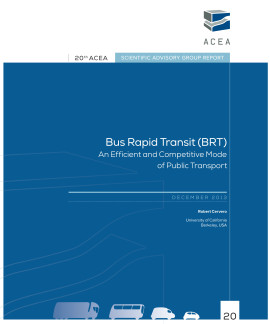The future for BRT is bright. Rapid motorisation and ever-worsening traffic conditions in many rapidly emerging
economies and fast-growing cities make investments in high-capacity, high-performance transit systems more imperative than ever. Mounting concerns over the long-term environmental and fiscal impacts of car-dependent sprawl, combined with global initiatives to dramatically curb carbon emissions, further favour a world of expanded transit services. The bulk of future population growth throughout the 21st century will be in settings conducive to BRT. According to UN Habitat (2011), most of the 2 billion new urban dwellers between now and 2030 will be in cities with populations of 100,000 to 500,000. In these places, less-expensive BRT networks are likely to be more cost-effective than metros or LRT systems. Even in more mature, advanced economies, budget constraints along with continuing growth on the urban fringes favour BRT over urban rail.
For large metropolitan areas, the choice between BRT and urban rail is fortunately not either-or. In cities as diverse
as Beijing, Los Angeles, Teheran, Delhi, Seoul and Mexico City, BRT and metrorail systems nicely co-exist. BRT can
be both a complement to and a substitute for rail. As cities, household structures, neighbourhood designs, societal
values and lifestyle choices continue to diversify, a more plural transportation landscape – one that provides a rich
set of mobility options at a range of price points – is needed. BRT stands poised to add to the mix of mobility choices over a wide range of urban contexts throughout the 21st century.
Rail versus bus is increasingly a false dichotomy. Less important than the physical apparatus – whether rubbertyres
on pavement or steel-wheel-on-steel-rail – is the quality of service delivered. In this regard, BRT gets high marks.
Its versatility at linking feeder and line-haul services in the same vehicle, and thus eliminating transfers, makes it particularly well suited for lower-density settings. As existing BRT systems expand, moreover, mobility and environmental benefits can be expected to accelerate due to network effects. Each new BRT line benefits not only those living, working and traveling to the newly served corridor, but also to residents and workers on existing corridors that can now reach new destinations.
As an industry, BRT is hardly static. As the BRT matures, new trends are emerging. These include: service and tariff
integration of BRT with citywide transit services, better ways of eliciting private participation in operations, increased funding support from national governments, BRT-oriented land development, and the growth of bus manufacturers and technology-providers from Brazil, India, Indonesia and China.
One thing that successful BRT cities like Bogotá, Curitiba and Seoul share in common is a legacy of strong and visionary political leadership. Cities that have failed to deliver the high-quality BRT services originally envisaged, such as Jakarta, Lagos and Santiago, fell short mainly because of political pressures to retain the status quo. In Jakarta’s first phase, the lack of integration between trunk and feeder vehicles, and unwillingness to prevent incumbent operators to run alongside BRT buses undermined service quality. “Ultimately, the obstacles to BRT development are more likely to be political than financial or technical. However, for the few political leaders who take the chance to redefine their cities with full BRT, the rewards are clear.”
